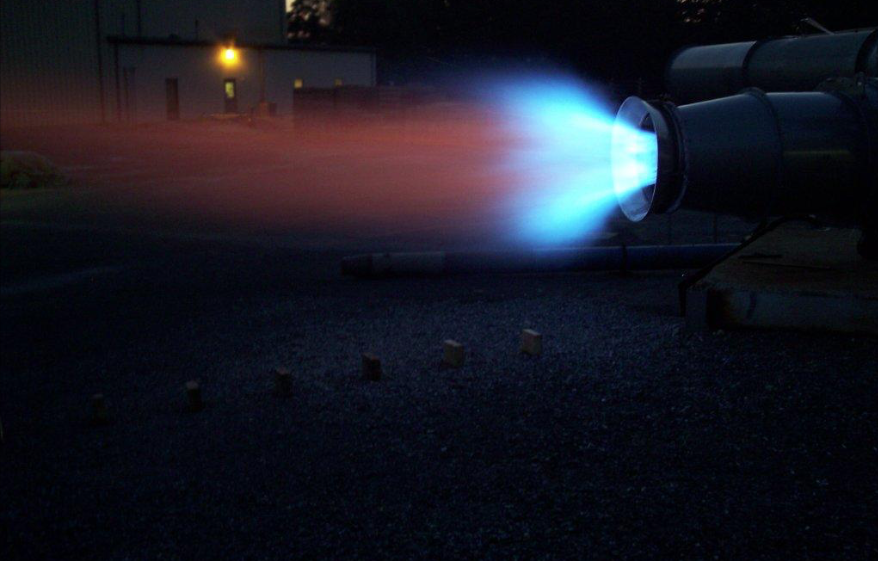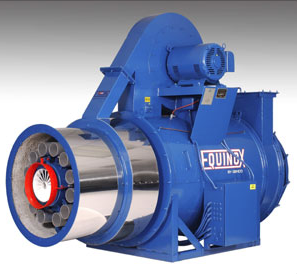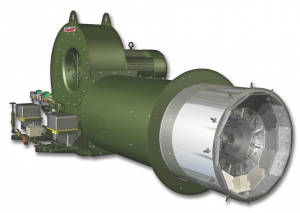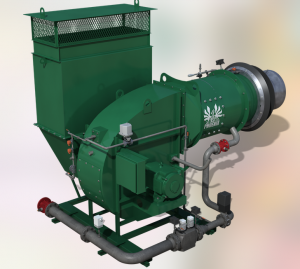Use Low NOx Burners to Decrease Emissions
BY AsphaltPro Staff

It may sound like a contradiction to use combustion to lower emissions, but industry has both smart operations and ever-advancing technology to reach the goal of more environmentally friendly output. From training your plant operator on best practices to tuning your existing burner for optimum efficiency for your specific production capacity to installing newly designed burners, you have options to ensure your asphalt plant meets nitrous oxide (NOx) emissions regulations in even low-attainment areas.

The EQUINOX™ burner from Genco is completely pre-assembled on a steel unitized frame. Photo courtesy Genco.
Check on Technology
Industry and entrepreneurs were concerned with NOx reduction back in 1977 when the John Zink Company applied for U.S. Patent No. 4,004,875 to develop a low-NOx burner. A year and a half later, Robert Reed filed for a related invention patent. He wished to design a burner to control the fuel and air supply within the burner “such as to maintain a minimum value of NOx in the effluent gases” no matter the fluctuations in burning rate or air supply rate.
By Aug. 30, 2000, Gencor Industries Inc., Orlando, filed a patent for the low emissions burner with premix flame stabilized by a diffusion flame. Now Genco, under the Gencor umbrella of companies, offers the EQUINOX™ combustion system, which is designed to reduce the use of flue gas recirculation, by a primary stage pre-mix accumulator and a second stage, patented injection system. The company states that this results in a stable combustion flame with little to no effect on the exhaust system of the process.
Early in the 2000s, Hauck Manufacturing Company worked with patents for a number of lean premix burners and three-stage burners. Paul Lavenberg, a spokesperson for Honeywell Thermal Solutions, Rockford, Illinois, which now owns and manufactures the Hauck brand, listed the following current patents.
- Hauck NovaStar Burner: US20140308619, US8113821
- Hauck EcoStar II and MegaStar Burners: 5700143
- Hauck EcoStar II, MegaStar and StarJet Burners: US6969249
Astec Industries, Chattanooga, offers the Phoenix® family of burners to mix the air and gaseous fuel for a low NOx and CO method called lean burn premix. Its ultralow-NOx burners “employ a multiple, parallel, turbulent, tube mixer to achieve near perfect mixing of fuel and air.” Running in lean burn mode allows a compact flame size, which the company states, “contributes to efficiency, ensuring that all of the fuel is combusted without taking away valuable heating capacity.”
It is evident that low-NOx burners—and ultralow-NOx burners—available for use in the asphalt industry have a solid family tree. Asphalt industry members remain on the cutting edge of environmental sustainability, working to keep actual emissions, and the implication of emissions, to a minimum.
GreenGlobes.com tells us, “When fossil fuels are burned, nitric oxide and nitrogen dioxide are produced.” The site also explains: “The nitrous oxides (NOx) come from two sources: high-temperature combustion (thermal NOx) and nitrogen bound to the fuel (fuel NOx). For clean-burning fuels like natural gas, fuel NOx generation is insignificant.”
For this reason, and others, researchers and developers wish to reduce flame temperature, and environmental groups wish to ensure everyone who uses a burner for any purpose uses a clean-burning fuel in the most efficient combustion process possible. The many patents filed, and alluded to above, to create low-NOx burners for a variety of industries focused on creating a “fuel-rich combustion zone” ahead of a “fuel-lean combustion zone.”
Lennie Loesch, the president and CEO of Stansteel/Hotmix Parts & Services™, Louisville, Kentucky, discussed efficient combustion and fuels. “Basically, NOx is formed at extremely high temperatures, over 2,800oF. This high temperature certainly occurs when you have a hotter burning fuel such as recycled fuel oil, waste oil and other items like that. For all practical purposes, about the only fuel that can be used, if you’re trying to get a low NOx level, is natural gas or propane.
“Because the bonding of the hydrocarbons and emissions happens over this high temperature,” Loesch continued, burner developers have sought ways to cool down the flame. “That can be done by quenching with air or recycled flue gas to bring back some of the gases that already have the oxygen out of them, to help supply a cooling air or cooling gas for the main primary combustion.”
Loesch mentioned the one-time popular idea of spraying water on the combustion air. “The water, of course, creates the need for more energy. Even though it may accomplish lower NOx, it’s at the tremendous cost of fuel efficiency.”
Honeywell’s Lavenberg discussed other ways technology can step in to help. “With some ultra low-NOx burners, pre-mixing the air and gas at certain air to fuel ratios allows for considerable flame temperature reduction and very effective NOx reduction. The use of ‘excess air’ allows this technology to work. Excess air is the use of additional air above and beyond the amount of air needed for perfect combustion to reduce flame temperatures.”
Lavenberg provided a list of ways flame temperatures can be mitigated:
- Water injection
- Fuel staging—prolongs and delays mixing of fuel and air, thereby reducing peak flame temperature. Fuel is introduced in “stages,” rather than one single point.
- Combustion air staging—prolongs and delays mixing of fuel and air, thereby reducing peak flame temperature. Air is introduced in “stages,” rather than one single point.
- Internal flue gas recirculation—fuel and air mixing turbulence recirculates products of combustion back into the flame causing reduced flame temperatures.
- External flue gas recirculation—a portion of the burner exhaust is reintroduced into the burner to reduce the oxygen content in the combustion air thereby reducing the flame temperature.
As of press time, only a handful of states require asphalt plants use a low-NOx burner for operation. California, New Jersey, New York and South Carolina have this on the books.
“Areas of non-attainment may have local air quality requirements that impact asphalt plants,” Lavenberg explained. “Contractors who are anticipating emissions regulations may be proactive in selecting a low-NOx burner for their plant. This can be risky if the proposed or actual regulations require lower emissions than certain burners are capable of.”
An example in New York gives some insight regarding the low-NOx justification in the environmental mindset, and offers a couple ideas for producers.
The New York State Department of Environmental Conservation (NYSDEC) issued a permit under the Environmental Conservation Law (ECL) to Gernatt Asphalt Products Inc., Collins, New York, for its Westfield Asphalt Paving Plant in Westfield, New York, June 1, 2011. That permit has no expiration date, but does allow inspections at “reasonable” intervals. The permit holder must follow a number of rules at all times or the department can modify the permit, suspend it, or flat out revoke it at any time.
“The grounds for modification, suspension or revocation include…Exceeding the scope of the project as described in the permit application; Newly discovered material information or a material change in environmental conditions, relevant technology or applicable law or regulations since the issuance of the existing permit….”
These conditions mean the owner of the Westfield plant must keep the facility operating in its original capacity within the DEC guidelines. It was permitted in 2011 with a 400 ton per hour production capacity. According to the permit, the dryer included a 100 mm BTU per hour low-NOx natural gas burner. The drum exhaust vented to a pulse jet baghouse with 70,000 ACFM. The permit includes a “federally enforceable emission cap that limits asphaltic concrete production to 450,000 tons during every 12 month period.”
The permit has a few other dictates, which offer a couple of best practices ideas. “As per 6NYCRR Part 212.12, this permit includes: (1) the requirement to complete an annual tune-up on the dryer burner, (2) a performance test of the dryer burner to demonstrate the burner is a low NOx burner, and (3) a plan which details methods to reduce the moisture content of the aggregate piles.”

Just this year, Honeywell Thermal Solutions supplied two MegaStar burners, which are conventional low-NOx burners, to a contractor in New York. Photo courtesy Honeywell Thermal Solutions.
Apply Your Knowledge
Tuning the burner on a regular basis and managing stockpiles to reduce moisture remain best practices for the asphalt producer, whether his facility is in a low-attainment area or not.
“The producer makes a huge mistake if he doesn’t have the burner adjusted and tuned by a qualified technician at least once per year,” Loesch said. “It is mandatory if different types of fuels are used because the air system, flighting and many other factors will affect not only the emissions, but also dramatically change the burning efficiency and fuel cost.”
Other best practices include training operators for optimum efficiency.
“First thing in the morning, you light up everything and put the burner on low heat,” A.J. Ronyak advised. He’s the proprietor of Odor Solutions Group and an asphalt production consultant. “Run the drum and conveyor belts dry on low heat for 30 minutes to an hour, depending on the time of the year, to warm up the baghouse and get the dew out. Then when you’re ready to start production, you’ve already created that hot air environment.”
One of the ways to optimize your burner use is to concentrate on moisture reduction before material even gets to the dryer. You’ve sloped and paved beneath the stockpiles; the RAP piles are covered to keep rainwater out. But humidity and moisture still sneak in. Companies like Ray-Tech Infrared Corp., Charlestown, New Hampshire, offer heating solutions ahead of the dryer to help reduce moisture significantly. “Then you can concentrate your heat on your aggregate and don’t have to worry about the RAP,” Ronyak said. What he suggested is to watch each material coming in. “Don’t try to conserve on the AC temperature. If you heat up the liquid AC, you can throttle back on the burner, and the guys on the street will still get their 300-degree mix to work with.”
These precise maneuvers require the plant operator to have confidence in his equipment. Honeywell’s Lavenberg pointed to the controls systems available in the industry to help operators. Plant controls can do so much more than blend mix these days.
“Often, advanced burner controls play a significant role in helping burners achieve precise, repeatable air-fuel ratio control, which contributes to NOx reduction,” Lavenberg shared.

Prior to shipment, each burner is tested on one of Astec’s tri-fuel (oil, gas & liquid propane) test stands to ensure fast and easy start-up at installation. This is the Phoenix® Phantom low-NOx burner. Photo courtesy Astec.
Loesch concurred. “New control systems…can be retrofitted to virtually any burner and will automatically adjust the air and fuel ratio by individual control modules.”
When you’re ready to make the upgrade to a low-NOx burner, it’s not as simple as switching out the burner and turning everything back on. As Loesch mentioned earlier, recycled fuels are no longer appropriate. Lavenberg explained that gaseous fuels are most suitable for use with low-NOx burners. This means you will need a source for natural gas or propane. Lavenberg listed some other things to consider:
- Combustion zone sizing in the dryer is important so the flame can fully develop without aggregate falling through the flame.
- Proper exhaust draft control—the exhaust system must be able to pull the products of combustion out of the dryer and allow for reasonable draft under production conditions.
- Be aware of possible contamination of aggregate from blasting compounds that contain nitrogen. In addition, materials may have agricultural runoff containing nitrogen as well.
- Precise air to fuel ratio control—use of electronic air/fuel biasing allows for precise control of air to fuel ratios.
State regulations may not require an upheaval of technology in your neck of the woods just yet. While you watch for new rules, keep the best practices mentioned above in mind to reduce your already low stack emissions now, and get prepped for just-in-case installation of a low-NOx burner in the future.
As of press time, only a handful of states require asphalt plants use a low-NOx burner for operation. California, New Jersey, New York and South Carolina, for example, have this on the books.
Clean Diesel Reduces Emissions
The success of private industry, government, environmental and health organizations in working to replace older diesel engines with near-zero emission clean diesel technology has reaped significant air quality improvements in the Midwest and throughout the United States, according to the Diesel Technology Forum.
In a presentation to the Midwest Clean Diesel Initiative (MCDI) in Chicago Oct. 26, Ezra Finkin, the director of policy for the Diesel Technology Forum, highlighted several of the clean air and health gains achieved over the past decade in reducing emissions from older diesel equipment.
The MCDI is a collaboration of federal, state and local agencies, along with communities, non-profit organizations and private companies all working together to reduce diesel emissions in Illinois, Indiana, Michigan, Minnesota, Ohio, and Wisconsin and 35 tribal nations.
Finkin outlined how new clean diesel heavy duty trucks (Model Year 2010 or newer) with near-zero emission have significantly reduced emissions by:
- Eliminating 7.5 million tonnes of NOx
- Eliminating 39 million tonnes of CO2
- And saving 2.9 billion gallons of diesel fuel (65 million barrels of oil)
Source: Diesel Technology Forum
